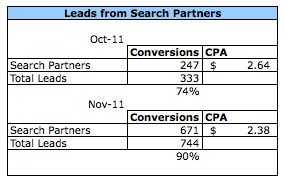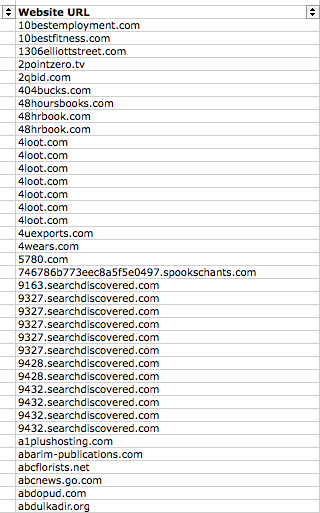November was going great for my account. Leads in adCenter had doubled in the last month and since the CPC is much lower than AdWords, our cost per leads was significantly below goal. It seemed too good to be true… and it was. About half way through the month, the client reached out to tell me something very strange was happening with their Bing leads. When the sales team would call the phone numbers listed, one of 2 things would happen:
- The phone number was accurate, but no one by the name on the form lived there.
- The name and number were accurate, but that person had never submitted their information to the site.
Some “bad” leads are expected, with people submitting false information, but this was more than a rare occurrence. About 10 of these types of leads were coming in each day. Luckily, the client was able to track these leads back to the source: Bing Search Partners.
I’d never really given much thought to Bing’s Search Partners before, but I quickly reached out to our rep to see what was going on. They mentioned they’d been having some issues with click fraud but that was in the education industry. But this was more than click fraud, this was lead fraud!
I decided to dig deeper into the issue myself and ran a publisher performance report for October and November. What I saw was very disheartening:
 Not only had the number of leads from search partners more than doubled from October to November, but they were making up the bulk of total leads, up to 90%! They were also incredibly cheap, so the main reason our cost per lead was looking so great in November.
Not only had the number of leads from search partners more than doubled from October to November, but they were making up the bulk of total leads, up to 90%! They were also incredibly cheap, so the main reason our cost per lead was looking so great in November.
So what did we do to correct this problem? Initially I would have the client send me a list of all of the referral sites for the bad leads. I would pass these along to our rep who would block our ads from showing on these sites. After 2 weeks though, there were so many bad referral sites coming through that we turned off search partners completely.
I reached out the Bing rep for more information about search partners and this was what I was told:
Our partner networks are very dynamic. Daily we add and remove partners and those partners are adding and removing sites from their networks daily as well. As a result, the sites your ads serve on across the networks do change over time.
That being said, in your case, there is probably something deeper going on with a partner other than that it is new (ie they added a site that is not providing quality traffic).
Our traffic quality teams have been notified of the issues… and are reviewing the partner traffic into the accounts. Any traffic they identify as poor quality or potentially fraudulent will be refunded to you. Beyond that, while we will not be told of any additional action, they usually review larger traffic metrics from the “problem” sites identified and may take action to remove that partner or site from the network.
So while it’s good we will be refunded the money for what is deemed “fraudulent” clicks, I don’t think we’ll be getting back the full amount we spent on these sites. I highly recommend everyone check the quality of the Search Parnters sites you are appearing on in Bing.
How To Check Bing Search Partner Quality
- Log into your account and go to the reports tab.
- Click create a new report and select Publisher Performance from the Report drop down.
- Select the date range you want to look at. I suggest running three reports for the last three months so you can see how traffic from these sites have changed.
- Select what data you want to include in the report. Remember, if you want to see conversion data you need to select it manually.
- Once you’ve downloaded your report, the column you want to focus on is “Website URL”. Ignore anything that says Bing and Yahoo! Search Properties Only. The rest of the websites are your search partners. Below is a screen shot of the first ones on my list:
Some sites look legit, like abcnews.go.com, but most well… don’t. Test your Search Partners by visting the URL. If you find many sites that look lower quality you can either exclude them or opt out of Search Partners all together. Search Partner options are set at the ad group level so it can be a pain to remove them manually. If you work with a Bing rep, reach out to them to exclude your whole account or do a bulk exclusion in the editor.
I wish I had noticed this issue with Bing Search Partners awhile ago so I wasn’t wasting money on bad clicks and leads. Hopefully this post has helped make you aware of this problem and save some of your ad spend!





